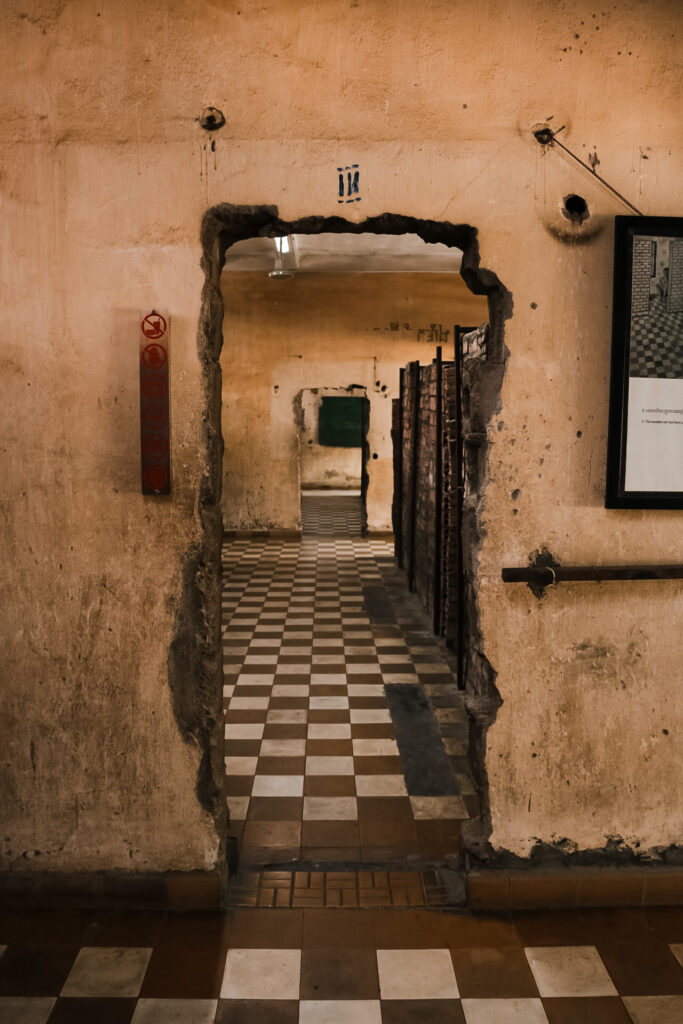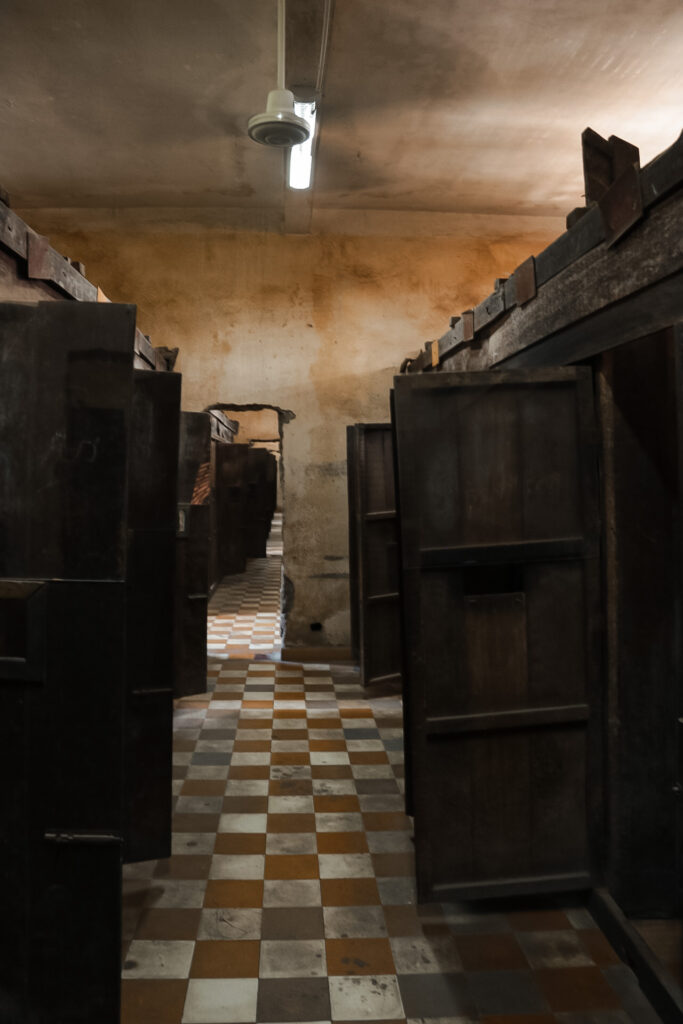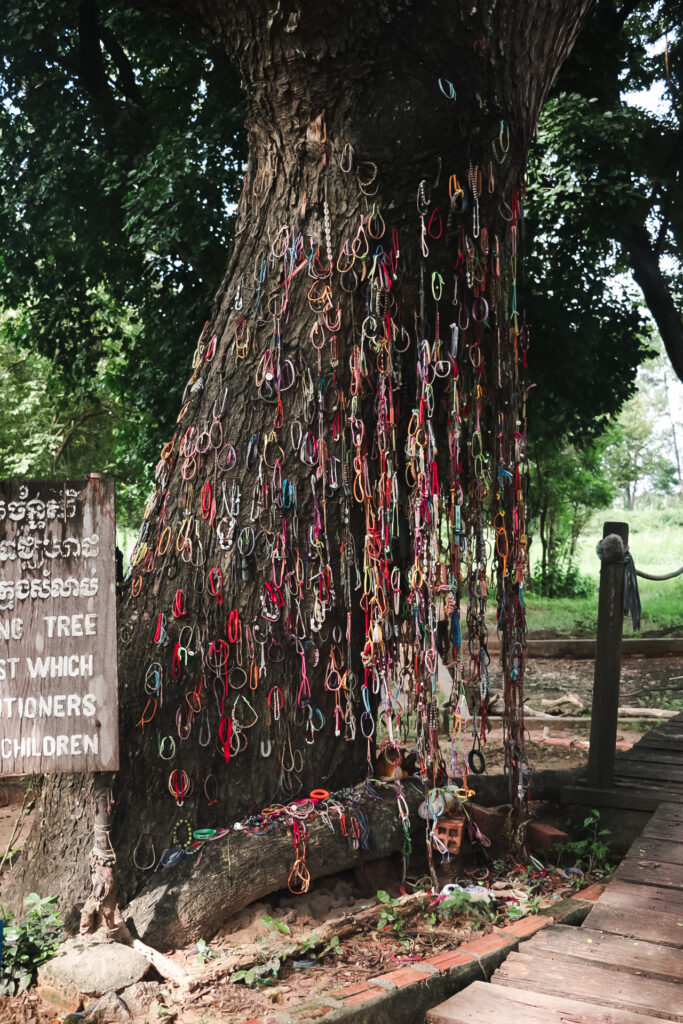The tragic history of Phnom Penh – Cambodia Travel Diary
Trigger warning: This blog entry deals, among other things, with the history of Phnom Penh in the years 1975 – 1979. Topics such as murder and torture are discussed here.
Off to new adventures
In the morning after breakfast at the hostel in Ho Chi Minh City, I was picked up by the Grab Taxi, which took me to the office of the bus company that took me across the Cambodian border to Phnom Penh.
The bus left Ho Chi Minh City at 8:30 am. But first we had to fight our way through the traffic of Ho Chi Minh City for a while. After a few hours we arrived at the border. Before that, the bus driver collected our passports.
At the border we all had to get off the bus and go into a building where we had to go through a security check and our passports were checked, which we then got back.
After we all went through security, we all got back on the bus and drove a little further. Then we had to get off the bus and give our passports to the bus driver again. Then our visas were checked. Luckily, the hostel had printed out my visa for me, so it went pretty quickly for me.
A few others had not printed out their visas, so they had to have them printed out on site. There they were also scammed because they gave their money to the wrong person. So it all took a while. When we were finally all done, we went back to the bus.
Without a passport in Cambodia
We had two bus drivers in total, and the driver who had our passports wasn’t on the bus when we left. We were all a little confused and a little nervous as we were getting farther and farther from the border without our passports.
Then we asked the bus driver where our passports were and when we would get them back. But he only said something about „10 minutes“ and drove on. We then had no choice but to wait.
After a few kilometers we stopped at a restaurant where we took a break. While our bus driver calmly ate his lunch, we continued to wait nervously for our passports. Finally the other bus driver arrived on a scooter and also had all our passports in his hand. But we didn’t get this again until we were already back in the bus and driving on.
After three more hours we arrived in Phnom Penh. But the traffic there was so heavy that we initially stood in traffic jams for a while until we were finally let out at the bus stop. From there it was almost 2 kilometers to the hostel.
Welcome to Phnom Penh
When we were let out there in the middle of the city, I didn’t have any cash or a SIM card. Luckily there were still a few British backpackers on my bus who had to go to the same hostel as me. There were a few TukTuk drivers at the bus stop, but the prices they quoted us were way too high.
Next to the bus stop was an ATM where we wanted to withdraw some money. But there we only got American dollars. There are two currencies in Cambodia. The national currency riel and American dollars. You can pay in dollars anywhere in the country, but it is always better to have the national currency. Especially since Cambodians only accept American dollars in very good condition. Even the smallest tear or crease will not be accepted.
One of the guys then bought a SIM card so we could at least call a Grab Taxi. As soon as the SIM card was activated, he then called two taxis, which we took to the hostel.
Before checking in at the hostel, I had to leave a key deposit of $5, which was only accepted as cash. So I had to go and withdraw money first. The ATM next to the hostel didn’t work though.
I was then still allowed to check in, but I had to leave my passport as a deposit. In the late afternoon I started looking for an ATM where I could finally withdraw money. Then I was able to pay the key deposit and got my passport back.
Family dinner at the hostel
In the evening I took part in the family dinner at the hostel. At $8 USD it was very expensive by Asian standards. But we had an all you can eat buffet and it’s a good opportunity to meet new people. I then spent the evening with two French people, one German and one Austrian. We talked a lot and played cards. When the bar closed at 11 pm., we went to bed.
The next morning I got up at 8 am and first went to the gym, something I haven’t done since I was in Kuala Lumpur. But before that I stopped at a shop and bought a SIM card there.
After training, I went to the supermarket and bought something for breakfast there. The food in the hostel is just overpriced and there weren’t many good restaurants near the hostel.
Visiting the S-21 Prison
I then had breakfast in the hostel and then got ready for the day. I went to the S-21 Prison shortly after 1 pm. S-21 Prison is now a museum commemorating the genocide in Cambodia in 1975-1979.
At the time, what is now the museum was a prison where the Khmer Rouge, who was in power at the time under Pol Pot, systematically held innocent people captive, tortured them, extracted confessions, and killed them after months of torture.

What exactly happened in Phnom Penh in 1975?
On April 17, 1975, the Khmer Rough, led by Pol Pot, captured the Cambodian capital, Phnom Penh. The goal of the Khmer Rough was to create a radical communist system. They wanted to create an original, agrarian society.


What is the S-21?
S-21 was one of the 196 prisons of Democratic Kampuchea. An estimated 12 000 – 20 000 Cambodians were held captive here. Only 12 people survived. Those admitted to S-21 were considered guilty.
If necessary, a confession was extracted through torture. It didn’t matter whether they were men, women or children.
The building is a former school building. It was used as a prison after the Khmer Rough conquest of Phnom Penh. Today it is a museum and memorial in memory of the numerous victims.


How did the Khmer Rough government end?
The Khmer Rough genocide ended on January 7, 1979 when Vietnamese troops expelled the rulers.
While visiting the prison, you can follow an audio tour through headphones. These are also available in numerous languages. Luckily for me also in German. You could always press numbers at the various stations and then something was told about the corresponding place. I was in the prison for almost two hours and listened to everything.

But I spent most of my time on the benches outside the prison buildings, listening to the stories there. I found the prison far too oppressive. Especially when you think about all the terrible things that happened there, you feel completely different.
When I was back on the street in front of the museum after two hours, I was quite relieved to finally be away from this place of horror. Nevertheless, I think it is important that you deal more with the history of the country in which you are staying.

Dinner with the boys
I spent the rest of the afternoon in the hostel. In my opinion, Phnom Penh is not the prettiest city either. But the city is surprisingly very modern. Sometimes it even looks pretty funny when tuk-tuks and scooters are still driving between the high-rise buildings and the many modern cars.
That evening I went out to dinner with the guys I met the night before. We walked the streets for a while looking for a good restaurant. However, most were far too expensive. In the end we decided on a restaurant that was close to our hostel.
The food was very good, but we didn’t really feel comfortable there. The waitress didn’t look happy at all and acted like she absolutely didn’t want us there.
As soon as we were done, we left pretty quickly. Before we went back to the hostel, we stopped again at the supermarket.
Phnom Penh’s Killing Fields
The next morning, like the morning before, I went to the gym. After training, I first bought a new charging cable because mine broke the day before. Finally I bought something to eat in the supermarket and had breakfast in the hostel. After I showered I drove to the Killing Fields with Simon, the German guy I met two days earlier. We took a TukTuk there as the Killing Fields are a bit outside of the city center. It started raining just as we drove off.
What are the killing fields?
The inmates of Prison 21 were executed after months of torture. For this they were taken to the so-called Killing Fields. The Khmer Rouge victims were not shot because cartridges were expensive and the shots would have been too loud. Today, Choeung Ek is a memorial site marked by a Buddhist stupa.
Visiting the killing fields
Also like the S-21 Prison, you can visit the Killing Fields with an audio tour. Listening to the stories was very depressing again. Especially since the killing fields are still mass graves today. Due to time and weather, bones and pieces of clothing keep coming up here, which are collected by the museum staff every few months and then put on display.
Once we both got through the memorial and listened to the full audio tour, we were quite relieved. You can’t stay in such a horrible place for too long. Especially when you see the „Killing Tree“ against which the Khmer Rouge people beated children to murder them while their mothers looked on.

Things like this are known because blood and brains were found on the tree after the discovery of the Killing Fields. The skulls of the corpses in the mass grave next to the tree showed the corresponding injuries.
Planning the next adventure
I spent the rest of the afternoon in the hostel. When I wanted to go out again around 5.30 pm. to explore the area, the sky was already quite dark. As soon as I was on the street, I saw the first lightning in the sky. I then decided to just go to the supermarket.
As soon as I came out of the supermarket, it was already raining. Luckily I had brought my rain jacket with me. Nevertheless, I came back to the hostel quite wet. I spent the rest of the evening there with Simon. I also booked my bus for the next day. My next destinations should be Kratie. I couldn’t book buses there at the hostel because it’s not a well-known place. Nevertheless, I wanted to go there because it had been recommended to me several times. I also wanted to experience something less touristy and get to know the country better.
I then researched for a while, but found no way to get to Kratie. Finally, someone at the reception helped me and recommended bookmebus.com to me. There I found a bus for the next day at 7 am. and booked it.
If you would like to know what I experienced during my time in Kratie, please read my next blog post Off the beaten part in Kratie – Cambodia Travel Diary.

